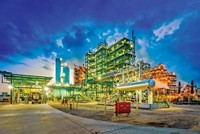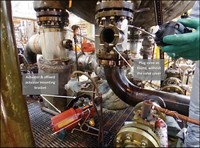Advertisement
Grab your lab coat. Let's get started
Welcome!
Welcome!
Create an account below to get 6 C&EN articles per month, receive newsletters and more - all free.
It seems this is your first time logging in online. Please enter the following information to continue.
As an ACS member you automatically get access to this site. All we need is few more details to create your reading experience.
Not you? Sign in with a different account.
Not you? Sign in with a different account.
ERROR 1
ERROR 1
ERROR 2
ERROR 2
ERROR 2
ERROR 2
ERROR 2
Password and Confirm password must match.
If you have an ACS member number, please enter it here so we can link this account to your membership. (optional)
ERROR 2
ACS values your privacy. By submitting your information, you are gaining access to C&EN and subscribing to our weekly newsletter. We use the information you provide to make your reading experience better, and we will never sell your data to third party members.
Industrial Safety
CSB reports on fatal incident at Wacker Chemie plant
Safety board finds that an overtightened bolt caused an acid release at the Tennessee facility
by Jeff Johnson, special to C&EN
June 21, 2023

Trapped five stories high in an expanding cloud of hydrogen chloride, three workers attempted to climb down from an equipment platform at Wacker Chemie’s polysilicon facility in Charleston, Tennessee. The three fell 21 m; one died and two were badly injured in the Nov. 13, 2020, accident.
So says a June 15 report on the incident by the US Chemical Safety and Hazard Investigation Board (CSB), an independent federal agency.
It found that seven contractors from two firms were working simultaneously on two unrelated maintenance projects on the equipment platform. They were placed in peril when a flange bolt on a heat exchanger outlet pipe was overtightened and broke, releasing hazardous HCl. The three who were working on the project involving HCl were wearing full-body, chemical-resistant suits, but the other four working on a nearby equipment-insulating project were wearing only flame-resistant clothing.
There was only one way to exit the platform, a staircase, and as the white cloud of HCl expanded, the workers on the platform were unable to see their surroundings or access the staircase, CSB says. Three of those without chemical-resistant suits began climbing down the side of the structure to escape but fell.
“This incident was completely preventable,” CSB Chairperson Steve Owens says in a statement. The CSB’s report found several issues that should be addressed to ensure safe operations whenever workers are working simultaneously on different projects in one area, particularly when handling hazardous materials.
The report singled out Wacker’s risk assessment and its failure to recognize the potential danger of conducting unrelated projects simultaneously while next to one another. Also, the CSB noted that Wacker management had been made aware of the need for a second exit from the platform 3 months before the incident but failed to act.
The CSB also found that Wacker had instructed contract pipe fitters to torque multiple flange bolts that had different torque requirements, yet the firm did not provide written procedures for the contractors to follow. Instead, they had to rely on the piping manufacturers’ equipment manual, which did not include torque specifics for all bolts, the CSB reports.
The report recommends that the US Occupational Safety and Health Administration require the coordination of simultaneous operations involving multiple work groups. It also recommends that the Center for Chemical Process Safety, a not-for-profit corporate membership group, create safety products and guidance on simultaneous operations.
In a statement, Wacker says it “supports these recommendations and has already implemented changes to improve our site safety as part of an intensive internal review of its facilities and operating and safety procedures. Wacker will continue to review and learn from CSB reports and recommendations about other industrial incidents to improve our safety.”








Join the conversation
Contact the reporter
Submit a Letter to the Editor for publication
Engage with us on Twitter